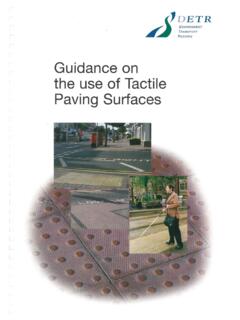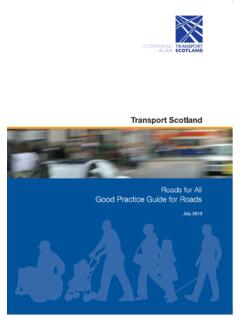Transcription of Public Right-of Way Accessibility Guidelines (PROWAG)
1 Right-of Way Accessibility Guidelines ( prowag )Juliet Shoultz, Systems EngineerUS Access Board2 Standards vs. Guidelines Guidelines are developed by the Access Board but must be adopted by another responsible agency to become enforceable standards. Current enforceable standard is 2010 ADA Standards FHWA Memo 1/23/06 prowag recommended best practices, and can be considered the state of the practice that could be followed for areas not fully addressed by the present ADA standards 3 Rulemaking Update The Access Board s regulatory plan anticipated completion of a final rule for Public rights -of-way and shared use paths. Executive Order 13771, Reducing Regulation and Controlling Regulatory Costsrequires for every one new regulation issued, at least two prior regulations be identified for elimination. Updates on unified Right of Way Accessibility Guidelines R1 Application and Administration R2 Scoping Requirements R3 Technical Requirements Pedestrian Access Route and Curb Ramps Accessible Pedestrian Signals Transit Stops/Shelters On-street parking R4 Supplementary Technical Requirements Takes ADA Building Standard Provisions and adapts them for ROW application 2013 SNPRM Incorporates Shared Use Path Guidelines5 Application and Administration Facilities for pedestrian circulation and use located in the Public Right-of -way Equivalent facilitation permitted Referenced standards MUTCD Definitions64 Scope of the Guidelines ADA and ABA Facilities New construction and alterations to existing facilities Temporary facilities are also covered (street fairs, block parties, farmers markets, presidential )
2 Existing facilities are covered by Standard setting agencies requirements7 Alterations Accessible to the extent practicable within the scope of the project Recommend documentation of decisions Transitional segment compliant to the extent practicable85 What s Required? prowag does notrequire Pedestrian Access Routes unless pedestrian facilities are provided. Ifsidewalks are provided, they are required to be accessible to and usable by persons with disabilities. 9 Types of Pedestrian FacilitiesPedestrian Access Routes (PAR)Shared-use Paths ShouldersSidewalks106 Pedestrian Access Route Width 48 min continuouspedestrian access route (PAR) If <60 passing space at 200 intervals4 feet minimum11 Shared Use Path Width Width determinedby use and not Accessibility and NOT controlled by our Guidelines Full width must meet PAR requirements127 Clear Width Around Obstructions 48 min clear width continued around obstructions13 Pedestrian Access Route Running Slope Within Street or Highway Right-of -Way.
3 The grade of pedestrian access routes shall not exceed the general grade established for the adjacent street or highway. Not Within Street or Highway Right-of -Way. The grade of pedestrian access routes shall be 5% Access Route Running Slope Within pedestrian street crossings: 5% maximum15 Pedestrian Street Crossings prowag does not specify when to Or how to mark (meet MUTCD requirements)169 Pedestrian Access Route Cross Slope 0% best for wheelchair users Some slope needed for drainage Max cross slope 2% Exceptions for street crossings17 Pedestrian Access Route Cross Slope Within Traffic Signalized Pedestrian Street Crossings: 5% max 18 Within Yield or Stop Controlled Pedestrian Street Crossings: 2% max10 Pedestrian Access Route Cross Slope19 Midblock Pedestrian Street Crossings: Street or highway gradeCross Slope at Driveways Pedestrian design does not have to be an after thought2011 Driveways If ROW is Firm, stable, and slip-resistant No large openings or gaps *New* ASTM E17 Committee has added provision on walking surface roughness2212 Properly installed, and well maintained bricks and flagstone and paving stones can work.
4 Surfaces23 Changes in Level Must be beveled if greater than Openings No more than inch opening in the direction of travel. 25 Flange Way Gap2614 Alternative Pedestrian Access Routes27 Temporary Route Basics prowag references MUTCD (section 6) Maintain pedestrian usability Same-side alternate routes if feasible Consider APS if extra crossings required Cane-detectable barricades 2815 From Part 6 of MUTCDT emporary Traffic Control29 Temporary TrafficControl3016 Curb Ramp Basics 1:12 max running slope (with length limit as exception to slope limit) 1:48 cross slope (with exceptions for stop condition) Width PAR is 48 min, Shared use path is full width Landing at top of perpendicular curb ramp Clear space at the bottom outside of parallel travel lane Flush transitions (no lips) Perpendicular grade breaks31 Anatomy of a Curb Ramp The cookie cutter curb rampTurning Space32 Curb Ramps17 Perpendicular Curb Ramps33 Perpendicular to the curb or streetParallel Curb Ramps34 Parallel to curb or street18 Types -Combination Combination ramps slope the sidewalk down and can shorten the perpendicular run to the street35 Blended Transitions Blended Transition (depressed corner)3619 Blended Transition Blended Transition (raised crossing)37 Diagonal/Apex can cause dangerous conflicts Onlypermitted in alterations as last optionDiagonal Curb Ramps3820 Two ramps per corner Street Crossing = Curb Ramp39 Maximum curb ramp slope 1.
5 12 When chasing grade length of the ramp can be limited to 15 Ramp Running SlopeMin 15 4021 Curb Ramp Cross Slope 1:48 max where crossing is stop or yield 1:20 max where crossing may be free flow41 PAR 48 inches minimum width. Curb ramp must extend full width of a shared use Ramp Width4222 Landings are required at the top of perpendicular curb ramps for change in direction of travel (4 x 4 min)Landings43 Landings Provide a level landing at the top of a perpendicular ramp, at the bottom of a parallel ramp4423 Landings The landing is at an intermediate level on a combination curb Grade breaks must be perpendicular to direction of travelGrade Breaks4624 Both wheels must hit the break at the same time for stability (especially manual wheelchairs)Perpendicular Grade Breaks 47 Counter Slope Algebraic difference of the ramp or landing slope and the street crown 13% max4825 Counter Slope Transition must be flush at all grade breaks49 Usable Curb Ramps?
6 Curb Ramps?51 What is wrong with these?Usable Curb Ramps?5227 BeforeAfter53 DetectableWarnings5428 Detectable Warnings Required at all street crossings Driveways?? Provide warning to the visually impaired that they are about to enter a hazardous area. 24 min. in the direction of travel and full width of curb opening Contrasting in color55 Detectable Warnings Required at boarding platforms Boarding and alighting areas at sidewalk or street level transit stops for rail vehicles 5629 Detectable Warnings All ramps and raised crossings must have detectable warnings to provide notice of the change from a pedestrian to a vehicular Due to their distinctive design, truncated domes are detectable by cane and to 50% to 65% of to to 5830 Minimum 24 in the direction of travelDetectable WarningsADAAG: Full depth and width of curb rampPROWAG: 24 inches and width of curb ramp59 DW needs to cover the entire flush edge DetectableWarnings6031 DW is placed at back of curb or at grade breakDetectableWarning Location61 Place DW on curb ramp at grade break if space at bottom of ramp is less than 5 deep Place DW on bottom behind the back of the curb if space is more than 5 deep at any point< 5 > 5 62 DetectableWarning Location32 Place at back of curb on landingDetectableWarning Location24 63 Detectable Warning Location Pedestrian refuge islands greater than 6 feet -DWs placed at front edge of island6433 Detectable Warning Location Detectable warnings at pedestrian/rail crossings 65 DW shall have a visual contrast with the surrounding surfaces (light on dark or dark on light) No specific color requiredDetectableWarnings6634 Protruding Objects Objects between 27 and 80 may not protrude more than 4.
7 Entire pedestrian circulation route!67 Protruding Objects Post mounted objects must not protrude more than 4 beyond the base Space greater than 12 between posts must be detectable6835 Detectable WarningQuiz69134342 Ramps Slope: 1:12 max Cross slope: 1:48 max Clear width: 36 min Rise for each run: 30 max Level landings Handrails (both sides) Edge protection7036 Ramps > 6 elevation change requires edge protection71 HandrailsRequired on ramps and stairs, if provided on walkways, not required on curb ramps Knuckle clearance: 1 min Diameter: 1 2 (applies to outer diameter) Circular & noncircular cross sections7237 Pedestrian Street Crossings Pedestrian heads with visual and audible information provided (Accessible Pedestrian Signal) Adequate crossing time ( feet/second(fps)) Multi-lane roundabouts needs some type of pedestrian demand signalization73 START-UP TIME AN ISSUEWALKING SPEED AN ISSUEC rossing Time fps from top of curb ramp toopposite curb prowag references MUTCD requirements7438 Crossing Time Curb extensions can reduce crossing distance75 Pedestrian Street Crossings Refuge islands can be useful7639 Pedestrian Street Crossings Prohibiting crossings Prohibit for ALL pedestrians77 Crossing Information Usable information about pedestrian street crossings 7840 Communication Features Locator tone Audible and vibro-tactile detectors required Tactile arrow indicating direction 10 ft.
8 Separation, or speech indication Volume adjusts for ambient noise Speech walk criteria MUTCD Extended Press FeaturesAccessible Pedestrian Signals (APS)79 Speakers are located on the device; at pedestrian levelAccessible Pedestrian Signals (APS)8041 Button Face of button parallel to crosswalk Mounted at 48 max (42 max used in MUTCD) Max 5 lbs pressure needed to activate Accessible Pedestrian Pushbuttons Sign & Arrow Sign adjacent to button explains purpose and use (MUTCD option) Arrow must indicate crosswalk direction81 Reach Ranges 48 max. 15 min. Side reach within 10 No obstruction permitted on forward reachAccessible Pedestrian Pushbuttons8242 Pushbutton SizeAccessible Pedestrian Pushbuttons Usable with a closed fist83 Tactile Arrow8443 Pushbutton Location Find the pushbutton. Now line up to cross. Missed your chance? Do it again85 Pushbutton Location Must be connected to a pedestrian access route8644 Pushbutton Location87 Between 1 1/2 ft and 6 ft from the edge of curb, shoulder or pavement No more than five feet from crosswalk linePushbutton Location8845 Pushbutton Location89 Face of pushbutton must be parallel to the crosswalkPushbutton Location9046 Roundabouts Sidewalks shall be separated for wayfinding Where pedestrians cross more than one lane, pedestrian-activated signals shall be Example of: Curb attached sidewalk and fencing to guide pedestrians to crossing location.
9 9247On-Street Parking Number of accessible spaces is based on total marked or metered spaces on a block perimeter Scoping Section Table R21493On-Street Parking Where the width of the adjacent sidewalk or available Right-of -way exceeds 14 ft. an access aisle is required (new construction)9448On-Street Parking Narrow sidewalks access aisle not required Alterations access aisle only required when scope of project involves curb and road work95On-Street Parking Angled (or perpendicular) on-street parking; requires an 8ft access aisle9649On-Street Parking Information must be visible from a point ft. max above the center of the clear space Must meet operable parts requirementsParking meter/pay station displays and information 97 Passenger Loading Zones The access aisle must be connected to the pedestrian access route9850 Clear space: 96 x60 Perpendicular to road 1:48 max slope; Parallel to the road can match grade of roadBus Boarding and Alighting Areas99 Bus Boarding and Alighting Areas10051 Space for wheelchair entirely within shelter Pedestrian accessible route connection to boarding/alighting areaBus Shelters 101 Questions?
10 102 Juliet Shoultz, Systems Access Board202-272-0045








